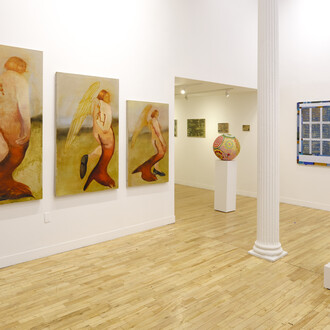Nicholas Bierk, Kensie Duffy, Katelyn Eichwald, Lindsay Merrill, Larysa Myers, Leonardo Ortega, Dana Powell, Bruce Richards, Lucy Sallick, Danny Sobor, Suyi Xu. Bookshelf objects courtesy of Eric Oglander.
The representation of a subject does nothing to transform the original thing as it exists in nature. However, the perception of objects can shift in response to the artist’s specific formal devices.
In 1962, Walter Hopps curates the first institutional survey of American Pop Art, thus initiating widespread recognition of the genre as a legitimate historical movement. He brings together Roy Lichtenstein, Jim Dine, Andy Warhol, Phillip Hefferton, Robert Dowd, Ed Ruscha, Joe Goode and Wayne Thiebaud, and names the collective presentation “New Painting of Common Objects.”
An encounter is staged between Ed Ruscha’s implementations of Americana, typeface, and product and Warhol’s cynical portraiture, which demarcates the image-world as one consigned to commerce and celebrity. Dowd’s and Hefferton’s money paintings meet Goode’s cloud and milk bottles. Jed Perl recognizes the latter for his “caricatural vision” that is “all about pop culture.” Appliances, clothing, and other supposedly “mundane” subjects are funneled into Jim Dine’s ongoing series. Thiebaud enters as an outsider whose saccharine pictures are described by Isabelle as looking “real, not because they are realistic but because they match everyone’s conception of the perfect hamburger or ice cream cone – a conception largely formed through visual advertising.”
In a related essay for Artforum, John Coplans compares the objectivity of Lichtenstein’s hairspray to that of Cézanne’s apple – these subjects having “nothing to do with any form of descriptive realism,” but, rather, develop from “the flashback of these visual effects.”
In 2012, Christopher Y. Lew updates Hopps’s project, staging the exhibition “New Pictures of Common Objects” at MoMA PS1. Works by Trisha Baga, Lucas Blalock, Josh Kline, Margaret Lee, and Helen Marten reflect the 21st century nature of image-object relationality. Lew cites that “today’s pictures circulate in an increasingly interactive and participatory manner, and the distinction between original and copy has been rendered more and more inconsequential.”
Technological advancements have engendered extreme circulation of pictures and ideas, as with the “divisions between high and low, culture and commodity, the object and its image matter less than before,” per the press release. Furthermore, this new, “decentralized model” of image distribution and flow begets new avenues for picture making. Marten reflects on this in an interview for Kaleidoscope, positing that “Objects are a kind of streamlined desire. I covet things desperately, but more as images or combinations of a pictorial or haptic intelligence. It's such a luxurious position to export things from everyday geographies into this very weird space we call art, to be able to use objects as though they were part of some kind of neutral alphabet.”
In 2023, the current exhibition at Fortnight Institute recognizes Hopps’s blockbusting presentation and Lew’s contemporary response, while offering a present update on their conceits. The central tenets here evolve from ideas about objecthood, under the conditions of extreme technocracy. Dana Powell’s striking rendering of shrink-wrapped fruits challenges the perceptivity of its viewer. The bounce of light against plastic sinks into the textured linen beyond, destabilizing the relationship of image and material. Lindsay Merrill, too, has produced a composition on the same surface. Cake matches geometric rendering of the sidewalk with softened contours of an abandoned dessert tray. In Dice, Nicholas Bierk represents a pair of the fuzzy cubes hanging from a rearview mirror. The painting appears like a still from a movie, seeped in honeyed sentimentality. Bierk has established an alliance with Goode, taking on the transience of memory and filtering it through still lifes and particular scenes. The two artists align, in particular, via the subject of painted milk bottles, harkening back to the iconography of rural America.
Danny Sobor, who relates to Hito Steyerl’s conception of “poor images,” selects pictures from internet searches, and injects them with personal affinities. Both candles (light in her doorway) and lamp (light in his office) are pulled from online, yet Sobor inscribes the scenes with memories of evening light in his childhood home. Katelyn Eichwald, too, extracts images from various media. Screenshots from films and other media are decisively cropped, then iterated with marked sensitivity. Leonardo Ortega, whose practice revolves around the “resignification” of sights and objects, has funneled his visions of Mexico into the paintings Primera parda and A la espera. A wheelbarrow and plastic chair are substitutes for vases, as flower piles inhabit their trough and seat, respectively.
Crucially, each artist here represents the object without disrupting its autonomy. This is accomplished through asserting a direct association with life itself, rather than the manufacture of “solutions” to life’s “problems.”
(Text by Reilly Davidson)














